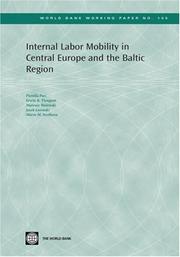| Listing 1 - 10 of 25 | << page >> |
Sort by
|

ISBN: 0821370901 082137091X Year: 2007 Publisher: Washington, D.C. : World Bank,
Abstract | Keywords | Export | Availability | Bookmark
 Loading...
Loading...Choose an application
- Reference Manager
- EndNote
- RefWorks (Direct export to RefWorks)
Large regional disparities in labor market indicators exist in Central Europe and the Baltic region. Such disparities appear to be persistent over time indicating, in part, a lack of flexibility in the prevailing adjustment mechanisms. Internal labor mobility is often seen as an important instrument to reduce adjustment costs when other mechanisms fail. Drawing from a variety of data sources and utilizing a common empirical framework and estimation strategy, this study identifies patterns and statistical profiles of geographical mobility. It finds internal migration to be generalily low and hi
Labor mobility -- Baltic States. --- Labor mobility -- Europe, Eastern. --- Migration, Internal -- Europe, Eastern. --- Labor mobility --- Migration, Internal --- Business & Economics --- Labor & Workers' Economics --- Internal migration --- Mobility --- Mobility, Labor --- Population geography --- Internal migrants --- Labor supply --- Labor turnover

ISBN: 0262100681 026227650X 0585108161 9780585108162 9780262276504 Year: 1998 Publisher: Cambridge, Mass. : MIT Press,
Abstract | Keywords | Export | Availability | Bookmark
 Loading...
Loading...Choose an application
- Reference Manager
- EndNote
- RefWorks (Direct export to RefWorks)
Income distribution --- Sex discrimination in employment --- Wages --- Longitudinal studies. --- Women --- Labor & Workers' Economics --- Business & Economics --- Longitudinal studies --- Compensation --- Departmental salaries --- Earnings --- Pay --- Remuneration --- Salaries --- Wage-fund --- Wage rates --- Working class --- Distribution of income --- Income inequality --- Inequality of income --- Sociology of work --- Sociology of minorities --- Great Britain --- Employment (Economic theory) --- Sex role in the work environment --- Sexual division of labor --- Income --- Labor costs --- Compensation management --- Cost and standard of living --- Prices --- Distribution (Economic theory) --- Disposable income --- Employment --- E-books --- Pay gap --- Labour market --- Book --- Chiffres --- Discrimination
Book
ISBN: 9780821375327 0821375326 9780821375334 0821375334 Year: 2008 Publisher: Washington, DC : World Bank,
Abstract | Keywords | Export | Availability | Bookmark
 Loading...
Loading...Choose an application
- Reference Manager
- EndNote
- RefWorks (Direct export to RefWorks)
Poor people derive most of their income from work; however, there is insufficient understanding of the role of employment and earnings as a linkage between growth and poverty reduction, especially in low income countries. To provide inputs into the policy discussion on how to enhance poverty reduction through increased employment and earnings for given growth levels, this study explores this linkage in the case of Bangladesh. The study provides a background discussion of poverty, reform, and growth in Bangladesh, followed by an overview of the labor market: demographies, the institutional stru
Labor market --- Wages --- Poverty --- Labor productivity --- Marché du travail --- Salaires --- Pauvreté --- Productivité --- Labor market. --- Business & Economics --- Labor & Workers' Economics --- Marché du travail --- Pauvreté --- Productivité --- Labor output --- Productivity of labor --- Compensation --- Departmental salaries --- Earnings --- Pay --- Remuneration --- Salaries --- Wage-fund --- Wage rates --- Working class --- Employees --- Market, Labor --- Supply and demand for labor --- Supply and demand --- Industrial productivity --- Capital productivity --- Hours of labor --- Labor time --- Productivity bargaining --- Income --- Labor costs --- Compensation management --- Cost and standard of living --- Prices --- Markets
Book
ISBN: 9780821375303 082137530X 9780821375310 0821375318 Year: 2008 Publisher: Washington, DC : World Bank,
Abstract | Keywords | Export | Availability | Bookmark
 Loading...
Loading...Choose an application
- Reference Manager
- EndNote
- RefWorks (Direct export to RefWorks)
Poor people derive most of their income from work; however, there is insufficient understanding of the role of employment and earnings as a linkage between growth and poverty reduction, especially in low income countries. With the objective of providing inputs into the policy discussion on how to enhance poverty reduction through increased employment and earnings for given growth levels, this study explores this linkage in the case of Madagascar using data from the national accounts and household surveys from the years 1999, 2001, and 2005, a period characterized among others by a short but se
Labor market --- Wages --- Poverty --- Labor productivity --- Marché du travail --- Salaires --- Pauvreté --- Productivité --- Labor market. --- Business & Economics --- Labor & Workers' Economics --- Marché du travail --- Pauvreté --- Productivité --- Labor output --- Productivity of labor --- Destitution --- Compensation --- Departmental salaries --- Earnings --- Pay --- Remuneration --- Salaries --- Wage-fund --- Wage rates --- Working class --- Employees --- Market, Labor --- Supply and demand for labor --- Supply and demand --- Industrial productivity --- Capital productivity --- Hours of labor --- Labor time --- Productivity bargaining --- Wealth --- Basic needs --- Begging --- Poor --- Subsistence economy --- Income --- Labor costs --- Compensation management --- Cost and standard of living --- Prices --- Markets
Book
ISBN: 082137107X 9786610940448 1280940441 0821371088 Year: 2007 Publisher: Washington, DC : World Bank,
Abstract | Keywords | Export | Availability | Bookmark
 Loading...
Loading...Choose an application
- Reference Manager
- EndNote
- RefWorks (Direct export to RefWorks)
There is one asset that poor people have in abundance: labor. Thus, what distinguishes the poor from the non-poor in low income countries is, simply, their ability to sell labor at a good price. It should be of little surprise, then, that enhancing the poor's access to employment is increasingly recognized as key to development. But while the creation of ""good"" jobs for the poor has become a policy priority for many developing countries, the mechanisms by which employment stimulates growth and reduces poverty have, until now, not been well understood. This book aims to help fill that gap. Fo
Labor supply. --- Labor supply --- Manpower policy --- Poverty --- Business & Economics --- Labor & Workers' Economics --- Employment policy --- Human resource development --- Labor market --- Labor market policy --- Manpower utilization --- Labor force --- Labor force participation --- Labor pool --- Work force --- Workforce --- Government policy --- Labor policy --- Trade adjustment assistance --- Human capital --- Labor mobility --- Manpower
Book
Year: 1996 Publisher: London The Toyota Centre, Suntory and Toyota International Centres for Economics and Related Disciplines, London School of Economics
Abstract | Keywords | Export | Availability | Bookmark
 Loading...
Loading...Choose an application
- Reference Manager
- EndNote
- RefWorks (Direct export to RefWorks)
Digital
Year: 2001 Publisher: Washington, D.C. World Bank
Abstract | Keywords | Export | Availability | Bookmark
 Loading...
Loading...Choose an application
- Reference Manager
- EndNote
- RefWorks (Direct export to RefWorks)
Digital
Year: 2002 Publisher: Washington, D.C. World Bank
Abstract | Keywords | Export | Availability | Bookmark
 Loading...
Loading...Choose an application
- Reference Manager
- EndNote
- RefWorks (Direct export to RefWorks)
Digital
Year: 2004 Publisher: Washington, D.C. World Bank
Abstract | Keywords | Export | Availability | Bookmark
 Loading...
Loading...Choose an application
- Reference Manager
- EndNote
- RefWorks (Direct export to RefWorks)
Book
Year: 2011 Publisher: Washington, D.C., The World Bank,
Abstract | Keywords | Export | Availability | Bookmark
 Loading...
Loading...Choose an application
- Reference Manager
- EndNote
- RefWorks (Direct export to RefWorks)
This paper reviews evidence from 44 middle-income countries on how the recent financial crisis affected jobs and workers' incomes. In addition to providing a rare assessment of the magnitude of the impact across several middle-income countries, the paper describes how labor markets adjusted and how the adjustments varied for different types of countries. The main finding is that the crisis affected the quality of employment more than the number of jobs. Overall, the slow-down in earning growth was considerably higher than that in employment, and the decline in gross domestic product was associated with a sharp decline in output per worker, particularly in the industrial sector. In several counties, hours per worker declined and hourly wages changed little. But both the magnitude and nature of the adjustments varied considerably across countries. For a given drop in gross domestic product, earnings declined more in countries with larger manufacturing sectors, smaller export sectors, and more stringent labor market regulations. In addition, overall employment became more sensitive to growth in gross domestic product. These findings have implications that go beyond the recent financial crisis as they highlight (i) the limitations of focusing policy responses on maintaining jobs and providing alterative employment or replacement income for the unemployed, and (ii) the critical role of fast-track data systems that are capable of monitoring ongoing labor market adjustment during economic downturns, in supporting the design of effective policy responses.
Banks & Banking Reform --- Employment --- Fast-track data systems --- Financial crisis --- Labor Management and Relations --- Labor market regulations --- Labor Markets --- Labor Policies --- Macroeconomics and Economic Growth --- Markets and Market Access --- Poverty Reduction --- Replacement income
| Listing 1 - 10 of 25 | << page >> |
Sort by
|

 Search
Search Feedback
Feedback About UniCat
About UniCat  Help
Help News
News